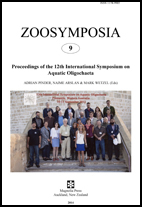Issue:
Vol. 9: 12 June 2014
Type: Article
Published: 2014-06-12
Page range: 51–58
Abstract views: 426
PDF downloaded: 445
Effects of sodium fluoride on the gametogenesis of the tubificid oligochaete Branchiura sowerbyi Beddard
Department of Biology, Padova University, Via U. Bassi 58/A, ITALY
Department of Biology, Padova University, Via U. Bassi 58/A, ITALY
Department of Biology, Padova University, Via U. Bassi 58/A, ITALY
fluoride effects
gametogenesis
Branchiura sowerbyi
freshwater oligochaete

